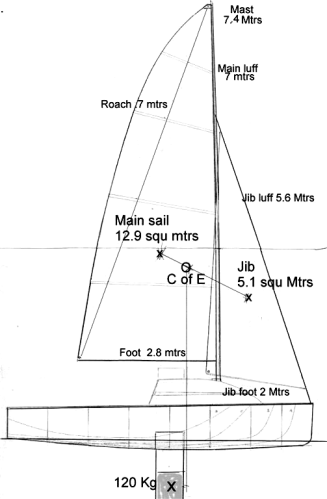from Rob Legg Yachts | |||||
|
|
|
|
|||
Part 3Now that we have decided on a vertical lift keel without bulb, we can progress to designing and positioning the final rig.
 The sail plan. First the centre of lateral resistance must be found. This is simple. A scale drawing including the boat below the water line, the keel, and the forward 20% of the rudder can be cut out of a piece of cardboard. Then find the balance point and this will be the centre of the boat’s lateral resistance. This point is marked on the drawing that we are working on. As the ballast in the keel is lower than originally estimated, and the boat is performance orientated, experience will tell us that around 18 square meters of sail would be a reasonable amount to handle for a crew of three utilising a skiff-type rig. I have drawn up a rig of that approximate size to find the position of the mast, (The final sail shape is best left to the sail maker who will match the cut to the mast.) With the rig drawn on a separate piece of paper it can be moved around until its centre of effort leads the centre of lateral resistance by the desired amount. Around 10% of the waterline length should be right on a boat that can de-power the mainsail. On looking at the combination of keel, rig, and cabin, it is obvious that in order to obtain adequate length, the keel will have to protrude above the cabin top when fully housed, and it may have to be lowered a little when raising the mast. The underwater dimensions of a keel are again a juggling act! The longer the keel, the less leeway, and the more righting moment it will produce. But that increases the wetted surface which decreases speed. Also there must be a practical limit regarding how it is to be handled. It appears that, for a keel of the section we are using, 4% of the sail area is about the minimum area we should use. I am not happy about depending on electrics on a small boat with no means of recharging a battery, so a self braking hand winch (worm drive) will be used to raise and lower the keel. Rather than go into the power developed by sails there is an interesting program that can be downloaded that will explain everything much better than I can, and although it probably is of more value for keel boats, it will give you a good insight in to the forces involved and it is interesting to play with. Thank you Alastair for bringing this program to my attention. Click to access WB-Sails Sail Power Calculator. (A new browser window will open.) Go back to Previous Episode | Go back to Index | Go on to Next Episode |


